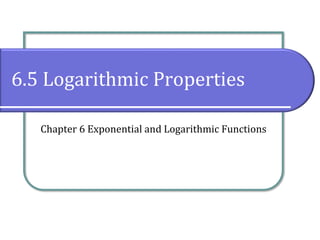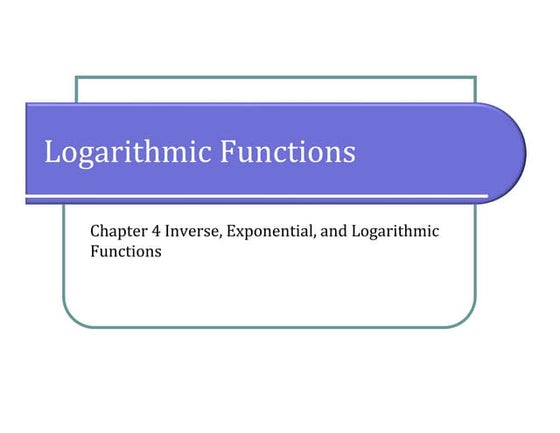6.5 Logarithmic Properties
0 likes109 views
* Use the product rule for logarithms. * Use the quotient rule for logarithms. * Use the power rule for logarithms. * Expand logarithmic expressions. * Condense logarithmic expressions. * Use the change-of-base formula for logarithms.
1 of 9
Download to read offline









Recommended
Lecture 11 sections 4.3-4.4 logarithmic functions



Lecture 11 sections 4.3-4.4 logarithmic functionsnjit-ronbrown
Ėý
This document discusses logarithmic functions and their properties. It begins with examples of converting between exponential and logarithmic form. It then covers the natural logarithm function and using transformations of logarithmic functions. The main section discusses properties of logarithms, including the product rule, quotient rule, and power rule for logarithms. It provides examples of writing logarithmic expressions using these rules in both expanded and condensed form.4.3 Logarithmic Functions



4.3 Logarithmic Functionssmiller5
Ėý
This document provides an overview of logarithmic functions. It defines logarithms as the inverse of exponents, where the logarithm of a number is the exponent that the base must be raised to to produce that number. It presents examples of solving logarithmic equations by rewriting them as exponential equations. The key properties of logarithms - that they satisfy the same properties as exponents - are described. The document works through multiple examples of evaluating logarithms and using their properties to simplify expressions and solve equations.Properties of logarithms



Properties of logarithmsJessica Garcia
Ėý
This document discusses properties of logarithms, including:
1) Logarithms with the same base "undo" each other according to the inverse function relationship between logarithms and exponents.
2) Logarithmic expressions can be expanded using properties to write them as sums or differences of individual logarithmic terms, or condensed into a single logarithm.
3) The change of base formula allows converting between logarithms with different bases, with common uses being to change to base 10 or the base of natural logarithms.Mc ty-logarithms-2009-1



Mc ty-logarithms-2009-1sheetslibrary
Ėý
Logarithms are used to replace multiplication with addition and division with subtraction. They allow calculations with large numbers to be simplified. There are three main laws of logarithms: 1) the logarithm of a product is equal to the sum of the logarithms of the factors, 2) the logarithm of a power is the power multiplied by the logarithm of the number, and 3) the logarithm of a quotient is equal to the logarithm of the dividend minus the logarithm of the divisor. Logarithms are commonly written to bases 10 and e, known as common logarithms and natural logarithms.Logarithms Text



Logarithms TextSifuDias
Ėý
Logarithms are used to replace multiplication with addition and division with subtraction. They allow calculations with large numbers to be simplified. There are three main laws of logarithms: 1) the logarithm of a product is equal to the sum of the logarithms of the factors, 2) the logarithm of a power is the power multiplied by the logarithm of the number, and 3) the logarithm of a quotient is equal to the logarithm of the dividend minus the logarithm of the divisor. Logarithms are commonly written to bases 10 and e, known as common logarithms and natural logarithms.Intro to Logs



Intro to Logstoni dimella
Ėý
The document introduces logarithms, defining them as the exponent that a fixed number (the base) must be raised to to equal the value. It provides examples of converting between logarithmic and exponential forms, and covers the key properties of logarithms including product, quotient, power, expanding, condensing, and the change of base formula.Logs



Logstoni dimella
Ėý
The document introduces logarithms, defining them as the exponent that a base number must be raised to to equal the value. It provides examples of converting between logarithmic and exponential forms, and discusses properties of logarithms such as the product, quotient, and power properties. It also covers expanding, condensing, and changing the base of logarithmic expressions.Logarithms- principal properties



Logarithms- principal propertiesAleRdzgarcia
Ėý
Logarithms are the inverse of exponential functions. A logarithm represents the power to which a base number must be raised to equal the output number. Logarithmic functions take the form y=logb(x), where b is the base, x is the output number, and y is the exponent or power. Common bases include base 10 and base e. Logarithmic functions have properties that allow logarithms with the same base to be added, subtracted, and multiplied according to certain rules. These properties can be used to solve exponential equations.Exponents and Logs



Exponents and LogsNeil MacIntosh
Ėý
This document covers exponents, logarithms, and their functions. It defines exponential and logarithmic expressions, reviews rules for manipulating exponents and logarithms, and examines the graphs of exponential and logarithmic functions. It provides examples of applying exponent and logarithm rules, and contains activities involving evaluating exponential and logarithmic expressions and graphing their related functions.8.5 properties of logarithms



8.5 properties of logarithmshisema01
Ėý
The document discusses properties of logarithms including:
- The product property which states that the logarithm of a product is the sum of the logarithms of the factors.
- How to use properties of logarithms to expand, condense, and change the base of logarithmic expressions.
- Examples are provided to demonstrate evaluating logarithmic expressions using the change of base formula and common/natural logarithms.Hprec5 5



Hprec5 5stevenhbills
Ėý
This document discusses the properties and laws of logarithms. It explains that common and natural logarithms have the same properties and laws, even though their bases differ. The key properties covered include: logarithms are only defined for positive values; ln1=0, ln e=1; and the product, quotient, and power laws. Several examples are worked through to demonstrate how to use these properties and laws to simplify logarithmic expressions and solve equations. The document emphasizes that understanding logarithmic properties and how to manipulate logarithms is important for advanced math, science, and engineering courses.Generalized Linear Models in Spark MLlib and SparkR by Xiangrui Meng



Generalized Linear Models in Spark MLlib and SparkR by Xiangrui MengSpark Summit
Ėý
Generalized linear models (GLMs) are a class of models that include linear regression, logistic regression, and other forms. GLMs are implemented in both MLlib and SparkR in Spark. They support various solvers like gradient descent, L-BFGS, and iteratively re-weighted least squares. Performance is optimized through techniques like sparsity, tree aggregation, and avoiding unnecessary data copies. Future work includes better handling of categoricals, more model statistics, and model parallelism.Generalized Linear Models in Spark MLlib and SparkR



Generalized Linear Models in Spark MLlib and SparkRDatabricks
Ėý
Generalized linear models (GLMs) unify various statistical models such as linear regression and logistic regression through the specification of a model family and link function. They are widely used in modeling, inference, and prediction with applications in numerous fields. In this talk, we will summarize recent community efforts in supporting GLMs in Spark MLlib and SparkR. We will review supported model families, link functions, and regularization types, as well as their use cases, e.g., logistic regression for classification and log-linear model for survival analysis. Then we discuss the choices of solvers and their pros and cons given training datasets of different sizes, and implementation details in order to match Râs model output and summary statistics. We will also demonstrate the APIs in MLlib and SparkR, including R model formula support, which make building linear models a simple task in Spark. This is a joint work with Eric Liang, Yanbo Liang, and some other Spark contributors.beyond linear programming: mathematical programming extensions



beyond linear programming: mathematical programming extensionsAngelica Angelo Ocon
Ėý
This document discusses integer programming and binary integer programming. Integer programming involves decision variables that must take on integer values. Binary integer programming uses binary variables that can only be 0 or 1. Examples show how to formulate integer programming models using binary variables to represent yes/no decisions and constraints. The key aspects of integer programming are ensuring decision variables are integers and that the optimal solution is also integer.Indices & logarithm



Indices & logarithmArjuna Senanayake
Ėý
Logarithms were originally developed to simplify complex arithmetic calculations by transforming multiplication into addition. A logarithm relates an exponential equation to its logarithmic form and vice versa. The key property of logarithms is that they allow rewriting exponential equations as logarithmic expressions and vice versa. This property is important for solving exponential equations. Logarithmic expressions are undefined if the argument is negative.Logarithms



LogarithmsBirinder Singh Gulati
Ėý
It includes concepts of logarithms including properties and log tables. The methodology to find out values using log tables and anti log tables is also mentioned in a detailed manner. Moreover, questions related to logarithms are mentioned for practice.Change of base hm3 (2019)



Change of base hm3 (2019)Ron Eick
Ėý
1. The document provides instructions and examples for using the change of base formula to convert between logarithmic bases and to solve exponential equations.
2. It introduces the change of base formula and shows examples of using it to convert log bases from base-3 to base-10 using a calculator.
3. Examples are given of using the change of base formula to solve exponential equations by taking the log of both sides and applying the formula.6.3 Logarithmic Functions



6.3 Logarithmic Functionssmiller5
Ėý
This document discusses logarithmic functions. It defines logarithms as the inverse of exponents and explains how to convert between logarithmic and exponential forms. Both common (base 10) and natural (base e) logarithms are covered. Examples show how to evaluate logarithms, rewrite expressions between logarithmic and exponential forms, and solve logarithmic equations for the variable. Practice problems are assigned from the textbook to reinforce the concepts taught.Aula



AulaMARCELACOSTA81
Ėý
The document summarizes 4 lessons on logarithmic properties:
Lesson 72 discusses logarithmic properties including product, quotient, power properties and changing bases.
Lesson 73 further discusses these properties and solving logarithmic equations.
Lesson 74 covers solving exponential equations using logarithms.
Lesson 75 involves solving word problems using logarithmic properties.Teoria y problemas de logaritmos l5 ccesa007



Teoria y problemas de logaritmos l5 ccesa007Demetrio Ccesa Rayme
Ėý
1. The document defines logarithms as the exponent to which a base must be raised to obtain a given number. It also discusses the fundamental properties and identities of logarithms.
2. The fundamental properties include: the logarithm of 1 is 0; the logarithm of the base is 1; the logarithm of a product is the sum of the logarithms of the factors; the logarithm of a quotient is the logarithm of the dividend minus the logarithm of the divisor.
3. The document also discusses cologarithms, antilogarithms, and provides examples of solving logarithmic equations.SRWColAlg6_0P_07.ppt



SRWColAlg6_0P_07.pptalexdomingo18
Ėý
This document provides an overview of rational expressions and operations involving rational expressions. It begins by defining fractional and rational expressions. It then covers performing operations like addition, subtraction, multiplication, and division on rational expressions. This involves using properties of fractions to simplify expressions and cancel common factors. The document also discusses domains, compound fractions, and examples involving calculus concepts.2 rules for radicals



2 rules for radicalsNikki Wilkinson
Ėý
The document discusses rules for simplifying radical expressions. It states that if the index of radicals in a division or multiplication expression are the same, the division can be rewritten as a division of the radicals and the multiplication can be rewritten as a multiplication of the radicals. Examples are provided to demonstrate simplifying expressions using these rules together with rules for rational exponents and reducing the index of fractional exponents.4.3 Logarithmic Functions



4.3 Logarithmic Functionssmiller5
Ėý
Solve an exponential equation using base 10 logarithms.
Find the missing part of a logarithm equation.
Use properties of logarithms to solve problems.Hprec5.1



Hprec5.1stevenhbills
Ėý
This document provides definitions and examples for working with radicals and rational exponents. It introduces rational exponents as exponents that can be written as fractions, and defines radicals with their index and radicand. Examples are provided for simplifying expressions with radicals through combining like terms, rationalizing denominators, and using properties of exponents. Practice problems are included for students to evaluate expressions and simplify using these concepts.Trigonometry 7.1 Angles (Degrees and Radians)



Trigonometry 7.1 Angles (Degrees and Radians)smiller5
Ėý
* Convert between degrees and radians
* Find coterminal angles
* Find the length of a circular arc
* Find the area of a sector
6.7 Exponential and Logarithmic Models



6.7 Exponential and Logarithmic Modelssmiller5
Ėý
* Model exponential growth and decay
* Use Newton's Law of Cooling
* Use logistic-growth models
* Choose an appropriate model for data
* Express an exponential model in base eMore Related Content
Similar to 6.5 Logarithmic Properties (20)
Exponents and Logs



Exponents and LogsNeil MacIntosh
Ėý
This document covers exponents, logarithms, and their functions. It defines exponential and logarithmic expressions, reviews rules for manipulating exponents and logarithms, and examines the graphs of exponential and logarithmic functions. It provides examples of applying exponent and logarithm rules, and contains activities involving evaluating exponential and logarithmic expressions and graphing their related functions.8.5 properties of logarithms



8.5 properties of logarithmshisema01
Ėý
The document discusses properties of logarithms including:
- The product property which states that the logarithm of a product is the sum of the logarithms of the factors.
- How to use properties of logarithms to expand, condense, and change the base of logarithmic expressions.
- Examples are provided to demonstrate evaluating logarithmic expressions using the change of base formula and common/natural logarithms.Hprec5 5



Hprec5 5stevenhbills
Ėý
This document discusses the properties and laws of logarithms. It explains that common and natural logarithms have the same properties and laws, even though their bases differ. The key properties covered include: logarithms are only defined for positive values; ln1=0, ln e=1; and the product, quotient, and power laws. Several examples are worked through to demonstrate how to use these properties and laws to simplify logarithmic expressions and solve equations. The document emphasizes that understanding logarithmic properties and how to manipulate logarithms is important for advanced math, science, and engineering courses.Generalized Linear Models in Spark MLlib and SparkR by Xiangrui Meng



Generalized Linear Models in Spark MLlib and SparkR by Xiangrui MengSpark Summit
Ėý
Generalized linear models (GLMs) are a class of models that include linear regression, logistic regression, and other forms. GLMs are implemented in both MLlib and SparkR in Spark. They support various solvers like gradient descent, L-BFGS, and iteratively re-weighted least squares. Performance is optimized through techniques like sparsity, tree aggregation, and avoiding unnecessary data copies. Future work includes better handling of categoricals, more model statistics, and model parallelism.Generalized Linear Models in Spark MLlib and SparkR



Generalized Linear Models in Spark MLlib and SparkRDatabricks
Ėý
Generalized linear models (GLMs) unify various statistical models such as linear regression and logistic regression through the specification of a model family and link function. They are widely used in modeling, inference, and prediction with applications in numerous fields. In this talk, we will summarize recent community efforts in supporting GLMs in Spark MLlib and SparkR. We will review supported model families, link functions, and regularization types, as well as their use cases, e.g., logistic regression for classification and log-linear model for survival analysis. Then we discuss the choices of solvers and their pros and cons given training datasets of different sizes, and implementation details in order to match Râs model output and summary statistics. We will also demonstrate the APIs in MLlib and SparkR, including R model formula support, which make building linear models a simple task in Spark. This is a joint work with Eric Liang, Yanbo Liang, and some other Spark contributors.beyond linear programming: mathematical programming extensions



beyond linear programming: mathematical programming extensionsAngelica Angelo Ocon
Ėý
This document discusses integer programming and binary integer programming. Integer programming involves decision variables that must take on integer values. Binary integer programming uses binary variables that can only be 0 or 1. Examples show how to formulate integer programming models using binary variables to represent yes/no decisions and constraints. The key aspects of integer programming are ensuring decision variables are integers and that the optimal solution is also integer.Indices & logarithm



Indices & logarithmArjuna Senanayake
Ėý
Logarithms were originally developed to simplify complex arithmetic calculations by transforming multiplication into addition. A logarithm relates an exponential equation to its logarithmic form and vice versa. The key property of logarithms is that they allow rewriting exponential equations as logarithmic expressions and vice versa. This property is important for solving exponential equations. Logarithmic expressions are undefined if the argument is negative.Logarithms



LogarithmsBirinder Singh Gulati
Ėý
It includes concepts of logarithms including properties and log tables. The methodology to find out values using log tables and anti log tables is also mentioned in a detailed manner. Moreover, questions related to logarithms are mentioned for practice.Change of base hm3 (2019)



Change of base hm3 (2019)Ron Eick
Ėý
1. The document provides instructions and examples for using the change of base formula to convert between logarithmic bases and to solve exponential equations.
2. It introduces the change of base formula and shows examples of using it to convert log bases from base-3 to base-10 using a calculator.
3. Examples are given of using the change of base formula to solve exponential equations by taking the log of both sides and applying the formula.6.3 Logarithmic Functions



6.3 Logarithmic Functionssmiller5
Ėý
This document discusses logarithmic functions. It defines logarithms as the inverse of exponents and explains how to convert between logarithmic and exponential forms. Both common (base 10) and natural (base e) logarithms are covered. Examples show how to evaluate logarithms, rewrite expressions between logarithmic and exponential forms, and solve logarithmic equations for the variable. Practice problems are assigned from the textbook to reinforce the concepts taught.Aula



AulaMARCELACOSTA81
Ėý
The document summarizes 4 lessons on logarithmic properties:
Lesson 72 discusses logarithmic properties including product, quotient, power properties and changing bases.
Lesson 73 further discusses these properties and solving logarithmic equations.
Lesson 74 covers solving exponential equations using logarithms.
Lesson 75 involves solving word problems using logarithmic properties.Teoria y problemas de logaritmos l5 ccesa007



Teoria y problemas de logaritmos l5 ccesa007Demetrio Ccesa Rayme
Ėý
1. The document defines logarithms as the exponent to which a base must be raised to obtain a given number. It also discusses the fundamental properties and identities of logarithms.
2. The fundamental properties include: the logarithm of 1 is 0; the logarithm of the base is 1; the logarithm of a product is the sum of the logarithms of the factors; the logarithm of a quotient is the logarithm of the dividend minus the logarithm of the divisor.
3. The document also discusses cologarithms, antilogarithms, and provides examples of solving logarithmic equations.SRWColAlg6_0P_07.ppt



SRWColAlg6_0P_07.pptalexdomingo18
Ėý
This document provides an overview of rational expressions and operations involving rational expressions. It begins by defining fractional and rational expressions. It then covers performing operations like addition, subtraction, multiplication, and division on rational expressions. This involves using properties of fractions to simplify expressions and cancel common factors. The document also discusses domains, compound fractions, and examples involving calculus concepts.2 rules for radicals



2 rules for radicalsNikki Wilkinson
Ėý
The document discusses rules for simplifying radical expressions. It states that if the index of radicals in a division or multiplication expression are the same, the division can be rewritten as a division of the radicals and the multiplication can be rewritten as a multiplication of the radicals. Examples are provided to demonstrate simplifying expressions using these rules together with rules for rational exponents and reducing the index of fractional exponents.4.3 Logarithmic Functions



4.3 Logarithmic Functionssmiller5
Ėý
Solve an exponential equation using base 10 logarithms.
Find the missing part of a logarithm equation.
Use properties of logarithms to solve problems.Hprec5.1



Hprec5.1stevenhbills
Ėý
This document provides definitions and examples for working with radicals and rational exponents. It introduces rational exponents as exponents that can be written as fractions, and defines radicals with their index and radicand. Examples are provided for simplifying expressions with radicals through combining like terms, rationalizing denominators, and using properties of exponents. Practice problems are included for students to evaluate expressions and simplify using these concepts.More from smiller5 (20)
Trigonometry 7.1 Angles (Degrees and Radians)



Trigonometry 7.1 Angles (Degrees and Radians)smiller5
Ėý
* Convert between degrees and radians
* Find coterminal angles
* Find the length of a circular arc
* Find the area of a sector
6.7 Exponential and Logarithmic Models



6.7 Exponential and Logarithmic Modelssmiller5
Ėý
* Model exponential growth and decay
* Use Newton's Law of Cooling
* Use logistic-growth models
* Choose an appropriate model for data
* Express an exponential model in base e4.5 Special Segments in Triangles



4.5 Special Segments in Trianglessmiller5
Ėý
* Construct perpendicular and angle bisectors
* Use bisectors to solve problems
* Identify the circumcenter and incenter of a triangle
* Use triangle segments to solve problems1.4 Conditional Statements



1.4 Conditional Statementssmiller5
Ėý
* Identify, write, and analyze conditional statements
* Write the inverse, converse, and contrapositive of a conditional statement
* Write a counterexample to a fake conjecture1.3 Distance and Midpoint Formulas



1.3 Distance and Midpoint Formulassmiller5
Ėý
* Find the distance between two points
* Find the midpoint of two given points
* Find the coordinates of an endpoint given one endpoint and a midpoint
* Find the coordinates of a point a fractional distance from one end of a segment1.5 Quadratic Equations.pdf



1.5 Quadratic Equations.pdfsmiller5
Ėý
This document provides instruction on factoring polynomials and quadratic equations. It begins by reviewing factoring techniques like finding the greatest common factor and factoring trinomials and binomials. Examples are provided to demonstrate the factoring methods. The document then discusses solving quadratic equations by factoring, putting the equation in standard form, and setting each factor equal to zero. An example problem demonstrates solving a quadratic equation through factoring. The document concludes by assigning homework and an optional reading for the next class.3.2 Graphs of Functions



3.2 Graphs of Functionssmiller5
Ėý
* Connect functions to their graphs
* Graph piecewise-defined functions
* Graph absolute value functions
* Graph greatest-integer functions
* Interpret graphs
* Use the vertical line test to determine a function
3.2 Graphs of Functions



3.2 Graphs of Functionssmiller5
Ėý
* Connect functions to their graphs
* Graph piecewise-defined functions
* Graph absolute value functions
* Graph greatest-integer functions
* Interpret graphs
* Use the vertical line test to determine a function
3.1 Functions



3.1 Functionssmiller5
Ėý
* Introduce functions and function notation
* Develop skills in constructing and interpreting the graphs of functions
* Learn to apply this knowledge in a variety of situations
2.5 Transformations of Functions



2.5 Transformations of Functionssmiller5
Ėý
* Recognize graphs of common functions.
* Graph functions using vertical and horizontal shifts.
* Graph functions using reflections about the x-axis and the y-axis.
* Graph functions using compressions and stretches.
* Combine transformations.
2.2 More on Functions and Their Graphs



2.2 More on Functions and Their Graphssmiller5
Ėý
This document discusses functions and their graphs. It defines increasing, decreasing and constant functions based on how the function values change as the input increases. Relative maxima and minima are points where a function changes from increasing to decreasing. Symmetry of functions is classified by the y-axis, x-axis and origin. Even functions are symmetric about the y-axis, odd functions are symmetric about the origin. Piecewise functions have different definitions over different intervals.1.6 Other Types of Equations



1.6 Other Types of Equationssmiller5
Ėý
This document provides examples and steps for solving various types of equations beyond linear equations, including:
1) Polynomial equations solved by factoring
2) Equations with radicals where radicals are eliminated by raising both sides to a power
3) Equations with rational exponents where both sides are raised to the reciprocal power
4) Equations quadratic in form where an algebraic substitution is made to transform into a quadratic equation
5) Absolute value equations where both positive and negative solutions must be considered.1.5 Quadratic Equations (Review)



1.5 Quadratic Equations (Review)smiller5
Ėý
This document provides instruction on factoring quadratic equations. It begins by reviewing factoring polynomials and trinomials. It then discusses factoring binomials using difference of squares, sum/difference of cubes, and other patterns. Finally, it explains that a quadratic equation can be solved by factoring if it can be written as a product of two linear factors. An example demonstrates factoring a quadratic equation by finding the two values that make each factor equal to zero.2.1 Basics of Functions and Their Graphs



2.1 Basics of Functions and Their Graphssmiller5
Ėý
This document provides an overview of functions and their graphs. It defines what constitutes a function, discusses domain and range, and how to identify functions using the vertical line test. Key points covered include:
- A function is a relation where each input has a single, unique output
- The domain is the set of inputs and the range is the set of outputs
- Functions can be represented by ordered pairs, graphs, or equations
- The vertical line test identifies functions as those where a vertical line intersects the graph at most once
- Intercepts occur where the graph crosses the x or y-axis9.6 Binomial Theorem



9.6 Binomial Theoremsmiller5
Ėý
The document discusses the binomial theorem, which provides a formula for expanding binomial expressions of the form (a + b)^n. It gives the formula for finding the coefficient of the term containing b^r as nCr. Several examples are worked out applying the binomial theorem to expand binomial expressions and find specific terms. Factorial notation is introduced for writing the coefficients. The document also discusses using calculators and Desmos to evaluate binomial coefficients. Practice problems are assigned from previous sections.13.3 Venn Diagrams & Two-Way Tables



13.3 Venn Diagrams & Two-Way Tablessmiller5
Ėý
The document discusses using Venn diagrams and two-way tables to organize data and calculate probabilities. It provides examples of completing Venn diagrams and two-way tables based on survey data about students' activities. It then uses the tables and diagrams to calculate probabilities of different outcomes. The examples illustrate how to set up and use these visual representations of categorical data.13.2 Independent & Dependent Events



13.2 Independent & Dependent Eventssmiller5
Ėý
* Identify events as independent or dependent
* Calculate the probabilities of independent and dependent events9.5 Counting Principles



9.5 Counting Principlessmiller5
Ėý
* Solve counting problems using the Addition Principle.
* Solve counting problems using the Multiplication Principle.
* Solve counting problems using permutations involving n distinct objects.
* Solve counting problems using combinations.
* Find the number of subsets of a given set.
* Solve counting problems using permutations involving n non-distinct objects.
13.1 Geometric Probability



13.1 Geometric Probabilitysmiller5
Ėý
* Calculate geometric probabilities
* Use geometric probability to predict results in real world situations.9.4 Series and Their Notations



9.4 Series and Their Notationssmiller5
Ėý
* Use summation notation.
* Use the formula for the sum of the ïŽrst n terms of an arithmetic series.
* Use the formula for the sum of the ïŽrst n terms of a geometric series.
* Use the formula for the sum of an inïŽnite geometric series.
* Solve annuity problems.Recently uploaded (20)
Dr. Ansari Khurshid Ahmed- Factors affecting Validity of a Test.pptx



Dr. Ansari Khurshid Ahmed- Factors affecting Validity of a Test.pptxKhurshid Ahmed Ansari
Ėý
Validity is an important characteristic of a test. A test having low validity is of little use. Validity is the accuracy with which a test measures whatever it is supposed to measure. Validity can be low, moderate or high. There are many factors which affect the validity of a test. If these factors are controlled, then the validity of the test can be maintained to a high level. In the power point presentation, factors affecting validity are discussed with the help of concrete examples.Intellectual Honesty & Research Integrity.pptx



Intellectual Honesty & Research Integrity.pptxNidhiSharma495177
Ėý
Research Publication & Ethics contains a chapter on Intellectual Honesty and Research Integrity.
Different case studies of intellectual dishonesty and integrity were discussed.Unit 1 Computer Hardware for Educational Computing.pptx



Unit 1 Computer Hardware for Educational Computing.pptxRomaSmart1
Ėý
Computers have revolutionized various sectors, including education, by enhancing learning experiences and making information more accessible. This presentation, "Computer Hardware for Educational Computing," introduces the fundamental aspects of computers, including their definition, characteristics, classification, and significance in the educational domain. Understanding these concepts helps educators and students leverage technology for more effective learning.Hannah Borhan and Pietro Gagliardi OECD present 'From classroom to community ...



Hannah Borhan and Pietro Gagliardi OECD present 'From classroom to community ...EduSkills OECD
Ėý
Hannah Borhan, Research Assistant, OECD Education and Skills Directorate and Pietro Gagliardi, Policy Analyst, OECD Public Governance Directorate present at the OECD webinar 'From classroom to community engagement: Promoting active citizenship among young people" on 25 February 2025. You can find the recording of the webinar on the website https://oecdedutoday.com/webinars/
Azure Data Engineer Interview Questions By ScholarHat



Azure Data Engineer Interview Questions By ScholarHatScholarhat
Ėý
Azure Data Engineer Interview Questions By ScholarHatInventory Reporting in Odoo 17 - Odoo 17 Inventory App



Inventory Reporting in Odoo 17 - Odoo 17 Inventory AppCeline George
Ėý
This slide will helps us to efficiently create detailed reports of different records defined in its modules, both analytical and quantitative, with Odoo 17 ERP.Oral exam Kenneth Bech - What is the meaning of strategic fit?



Oral exam Kenneth Bech - What is the meaning of strategic fit?MIPLM
Ėý
Presentation of the CEIPI DU IPBA oral exam of Kenneth Bech - What is the meaning of strategic fit? Báŧ TEST KIáŧM TRA GIáŧŪA KÃ 2 - TIášūNG ANH 10,11,12 - CHUášĻN FORM 2025 - GLOBAL SU...



Báŧ TEST KIáŧM TRA GIáŧŪA KÃ 2 - TIášūNG ANH 10,11,12 - CHUášĻN FORM 2025 - GLOBAL SU...Nguyen Thanh Tu Collection
Ėý
https://app.box.com/s/ij1ty3vm7el9i4qfrr41o756xycbahmgFunctional Muscle Testing of Facial Muscles.pdf



Functional Muscle Testing of Facial Muscles.pdfSamarHosni3
Ėý
Functional Muscle Testing of Facial Muscles.pdfInterim Guidelines for PMES-DM-17-2025-PPT.pptx



Interim Guidelines for PMES-DM-17-2025-PPT.pptxsirjeromemanansala
Ėý
This is the latest issuance on PMES as replacement of RPMS. Kindly message me to gain full access of the presentation. RRB ALP CBT 2 Mechanic Motor Vehicle Question Paper (MMV Exam MCQ)



RRB ALP CBT 2 Mechanic Motor Vehicle Question Paper (MMV Exam MCQ)SONU HEETSON
Ėý
RRB ALP CBT 2 Mechanic Motor Vehicle Question Paper. MMV MCQ PDF Free Download for Railway Assistant Loco Pilot Exam.Azure Administrator Interview Questions By ScholarHat



Azure Administrator Interview Questions By ScholarHatScholarhat
Ėý
Azure Administrator Interview Questions By ScholarHatEffective Product Variant Management in Odoo 18



Effective Product Variant Management in Odoo 18Celine George
Ėý
In this slide weâll discuss on the effective product variant management in Odoo 18. Odoo concentrates on managing product variations and offers a distinct area for doing so. Product variants provide unique characteristics like size and color to single products, which can be managed at the product template level for all attributes and variants or at the variant level for individual variants.RRB ALP CBT 2 RAC Question Paper MCQ (Railway Assistant Loco Pilot)



RRB ALP CBT 2 RAC Question Paper MCQ (Railway Assistant Loco Pilot)SONU HEETSON
Ėý
RRB ALP CBT 2 RAC Question Paper MCQ PDF Free Download. Railway Assistant Loco Pilot Mechanic Refrigeration and Air Conditioning Important Questions.Blind spots in AI and Formulation Science, IFPAC 2025.pdf



Blind spots in AI and Formulation Science, IFPAC 2025.pdfAjaz Hussain
Ėý
The intersection of AI and pharmaceutical formulation science highlights significant blind spotsâsystemic gaps in pharmaceutical development, regulatory oversight, quality assurance, and the ethical use of AIâthat could jeopardize patient safety and undermine public trust. To move forward effectively, we must address these normalized blind spots, which may arise from outdated assumptions, errors, gaps in previous knowledge, and biases in language or regulatory inertia. This is essential to ensure that AI and formulation science are developed as tools for patient-centered and ethical healthcare.Báŧ TEST KIáŧM TRA GIáŧŪA KÃ 2 - TIášūNG ANH 10,11,12 - CHUášĻN FORM 2025 - GLOBAL SU...



Báŧ TEST KIáŧM TRA GIáŧŪA KÃ 2 - TIášūNG ANH 10,11,12 - CHUášĻN FORM 2025 - GLOBAL SU...Nguyen Thanh Tu Collection
Ėý
6.5 Logarithmic Properties
- 1. 6.5 Logarithmic Properties Chapter 6 Exponential and Logarithmic Functions
- 2. Concepts & Objectives âŦ Objectives for this section are âŦ Use the product rule for logarithms. âŦ Use the quotient rule for logarithms. âŦ Use the power rule for logarithms. âŦ Expand logarithmic expressions. âŦ Condense logarithmic expressions. âŦ Use the change-of-base formula for logarithms.
- 3. Properties of Logarithms âŦ Because logarithms are exponents, they have three properties that come directly from the corresponding properties of exponentiation: Exponents Logarithms a b a b x x x + = a a b b x x x â = ( ) b a ab x x = ( ) log log log a b a b = + log log log a a b b ïĶ ïķ = â ï§ ï· ïĻ ïļ log log b a b a =
- 4. Examples 1. Write log224 â log28 as a single logarithm of a single argument. 2. Use the Log of a Power Property to solve 0.82x = 0.007.
- 5. Examples 1. Write log224 â log28 as a single logarithm of a single argument. 2. Use the Log of a Power Property to solve 0.82x = 0.007. 2 2 2 24 log 24 log 8 log 8 ïĶ ïķ â = ï§ ï· ïĻ ïļ 2 log 3 = 2 log0.8 log0.007 x = 2 log0.8 log0.007 x = log0.007 11.12 2log0.8 x = ïŧ = 2 0.8 0.007 x
- 6. Change-of-Base Formula âŦ Although the calculators we use in class, as well as Desmos, will calculate a logarithm using any base, it can sometimes be useful to change a logarithm from one base to another. For any positive real numbers M, b, and n, where n ïđ 1 and b ïđ 1, = log log log n b n M b
- 7. Examples 1. Change log53 from base 5 to base 10. 2. Change log0.58 to a quotient of natural logarithms.
- 8. Examples 1. Change log53 from base 5 to base 10. Applying the formula: M = 3, b = 5, and n = 10: 2. Change log0.58 to a quotient of natural logarithms. Now M = 8, b = 0.5, and n = e: 10 5 10 log 3 log3 log 3 or log 5 log5 = 0.5 ln8 log 8 ln0.5 =
- 9. Classwork âŦ College Algebra 2e âŦ 6.5: 4-14 (even); 6.3: 26-40 (even); 6.1: 62-68 (even) âŦ 6.5 Classwork Check âŦ Quiz 6.3








